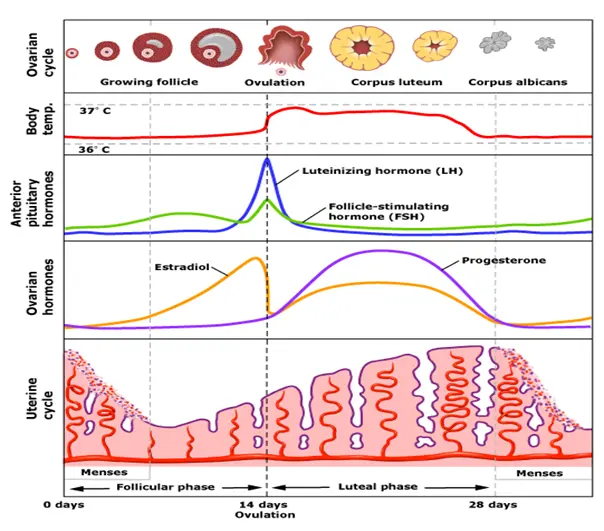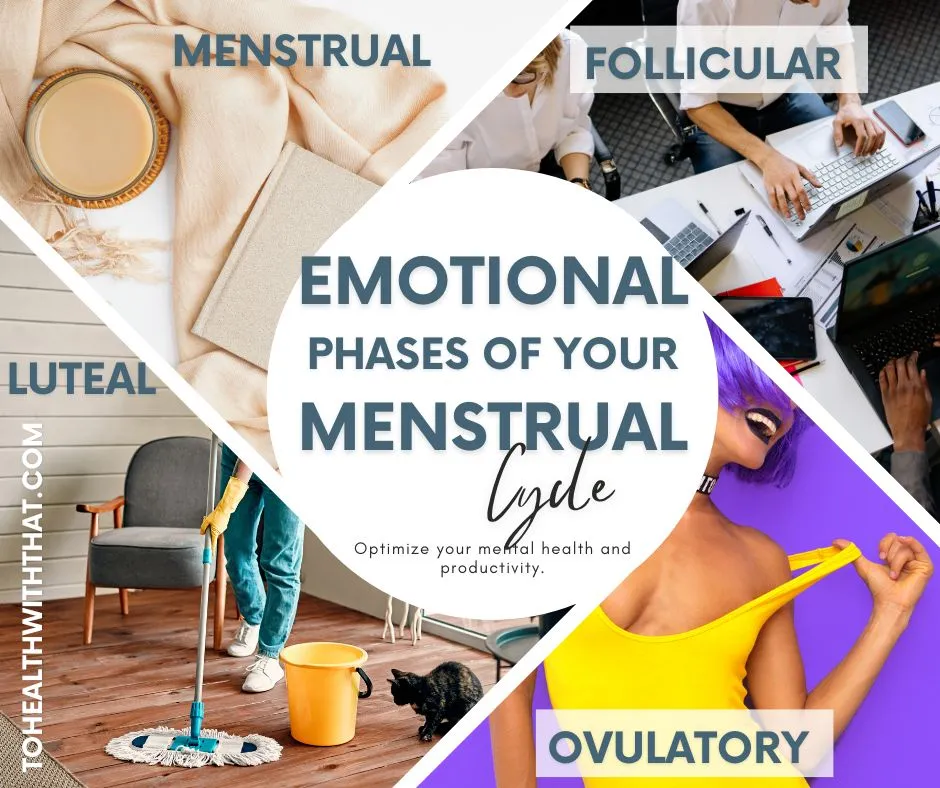Women are cyclic creatures, and understanding your cycle can help you understand your moods, body, and head-space. This monthly rhythm will define your life during your reproductive years as a woman, and the more you understand and notice what your body is doing, the more you’re able to optimize your health and wellbeing.
Four Phases of a Normal Menstrual Cycle.
Most doctors and online resources break the menstrual cycle up into two phases, which is of course accurate, but doesn’t necessarily reflect the experience of the woman having the cycle.
To accurately represent the experience of your cycle, I think four phases are necessary, and maybe even five.

Menstrual – This is when your uterine lining is shedding, meaning that you are not pregnant and the follicle your body released last month either wasn’t fertilized or didn’t implant. We start with this because conventionally when you’re charting your cycle, day 1 of your cycle is the first day you bleed. When your doctor asks you what the first day of your last menstrual period was, he or she is looking for the first day of bleeding. Hormones, energy, and body temp are at their lowest point. Technically this is considered a part of the follicular phase because a new follicle, or egg, is beginning to mature in your ovaries.
- This is your bleeding days.
- Energy is typically at it’s lowest
- Body temp and hormones are lowest as well
- Technically part of the follicular phase
- A new egg is already beginning to ripen in your ovaries in preparation for this month’s fertile time.
Follicular – Although this phase starts at menstruation, it continues on for the first two week of your cycle, up until ovulation. Your ovaries are growing and ripening a follicle (or egg). Estrogen is on the rise and it peaks just before ovulation. Pituitary hormones rise at the end of the follicular phase in order to trigger the actual release of the egg.
- The follicular phase after menstruation has finished is usually the easiest part of the cycle for women’s symptoms.
- Energy is usually good, as are mood, focus, and clarity.
- Body temperature is still relatively low, but will rise with ovulation.
- Estrogen is rising and gives you lots of pep.
Ovulatory – Ovulation is it’s own distinct process because there are many strong hormone changes happening to trigger the release of your egg and to attract a mate and make you want to go out and get baby-making. Many women experience ovulatory symptoms – migraine, mittleschmerz (which is ovulatory pain), night sweats, or cramping. Also typically sex drive is highest at this phase of the cycle. Estrogen drops sharply during ovulation and body temperature rises. If you’re charting your cycle this is one of the best ways to identify your ovulation.
- Huge hormone shifts happen right here. Your pituitary signaling hormones rise sharply, estrogen drops off a cliff, and progesterone starts to take over.
- Body temperature rises sharply
- You feel sexiest and also are perceived as looking your sexiest because other people can sense your ovulation in some mysterious way. Research shows that men are more likely to make “risky decisions” when women are ovulating.
- You dress the sexiest. No joke, research shows that women are more likely to wear sexier clothing during high fertility times of their cycle than they are at low fertility times.
- Some people have symptoms for this brief (72 hour) phase including migraine, ovulatory pain (mittleschmerz)
Luteal – After ovulation, the ovarian follicle changes form to become a corpus luteum (hence luteal cycle). This secretes progesterone, which rises during this phase of the cycle as the uterine lining thickens and ripens. If conception happens then there is no menstruation and the egg settles in to its cushy new home in the uterus. If there is no conception, then the luteal phase ends when menstruation begins. For women who have premenstrual symptoms, PMS, or PMDD, this phase can be fraught with difficulty because either the entire luteal phase is difficult or the second half is.
- This part of your cycle is dominated by progesterone
- Body temperature stays higher through this phase until you begin menstruation.
- This is the most common part of your cycle to experience symptoms and difficulties such as PMS and PMDD
For the average woman this cycle is 27 – 30 days, with 28 being the most optimal. Your cycle doesn’t just affect your uterus. This is a whole body process – many women see predictable changes in sleep, mood, sexual desire, energy, headspace, and even things like magnesium levels.

The Emotional Aspect of Your Cycle
From a more esoteric perspective, your monthly cycle mirrors personal growth cycles and can be a great rhythm to live by.
In this sense the menstrual phase is all about letting go, getting rid of, minimizing, streamlining, burning away what is no longer useful, and going within to do your inner work. This is an internally active but externally more sedentary phase.
Your follicular phase is for growth and preparation in the physical world. This is the time to bring ideas into existence. Your energy is likely to be good and balanced and passion and sex drive are increasing.
The ovulatory phase is when you’re on top of the world. Your physical energy is highest, sex drive is highest, even your magnetism and actual attractiveness are highest. Generally, this is the time when you are most likely to feel like a rockstar.
The luteal phase of your cycle is when things slower, get cushy and nesty, and begin to turn inward. This is when you start rearranging the furniture and doing more of the assessment that follows the active burst of the follicular phase. This is also when you are more likely to start noticing the things that need to be pruned out in your menstrual phase. If you have difficult emotions arise relative to your hormones it is most likely to show up in this phase during PMS or PMDD.
Your menstrual cycle is a rhythm that your body lives by no matter what, and it can enhance your relationship with yourself and your effectiveness in the world to live into it mentally and emotionally as well.
If you want to find out what’s normal for you, you should keep a calendar of your menstrual cycle. Identify the regularity of your cycle by tracking your start date every month for a period of several months so that you can determine how consistent your cycle is.
The following are some things to keep in mind every month if you’re concerned about your period:
- End date. When it comes to your period, how long does it usually last? Is it longer or shorter than it usually is?
- Flow. Make a note of the heaviness of your flow. Do you feel that it is lighter or heavier than usual? In terms of sanitary protection, how often should you change it? Is there any blood clots that you have passed recently?
- Abnormal bleeding. When you are between periods, do you experience bleeding?
- Pain. In case you are experiencing any pain during your period, please describe it in as much detail as possible. In comparison to how it usually feels, how bad does the pain feel compared to how it usually feels?
- Other changes. Have you noticed any changes in your mood or behavior recently? Was there anything new that happened around the time that your periods changed?
Menstrual irregularities should be discussed with your health care provider. Although birth control pills are commonly used to regulate menses, many women do not feel well with them or suffer from depression or anxiety while on “the pill.” There are many natural options to regulate hormone balance and cycle as well. One of the easiest to do without practitioner guidance is seed cycling. Otherwise, get the opinion of a qualified naturopathic doctor or integrative medical practitioner.
Additionally, you should consult your doctor or gynecologist if you suspect that:
- There has been a sudden cessation of your periods for over 90 days, but you are not pregnant.
- Previously regular periods have become erratic or you’ve noticed a drastic change in your menstrual patterns.
- It seems as though you bleed more heavily than usual or that you need to use more than one pad or tampon in a short period of time.
- The interval between your periods is less than 21 days or more than 35 days.
- When you are between periods, you bleed.
- When you are going through your period, you begin to experience severe pain.
- You feel sick or get a fever after using tampons.
MTHFR is a common genetic mutation that can contribute to anxiety, depression, fatigue, chronic pain, infertility, and more serious conditions like breast implant illness, heart attack, stroke, chronic fatigue syndrome, and some types of cancer. If you know or suspect you have an MTHFR variant, schedule a free 15-minute meet-and-greet appointment with MTHFR expert Dr. Amy today.
Book Your Appointment
